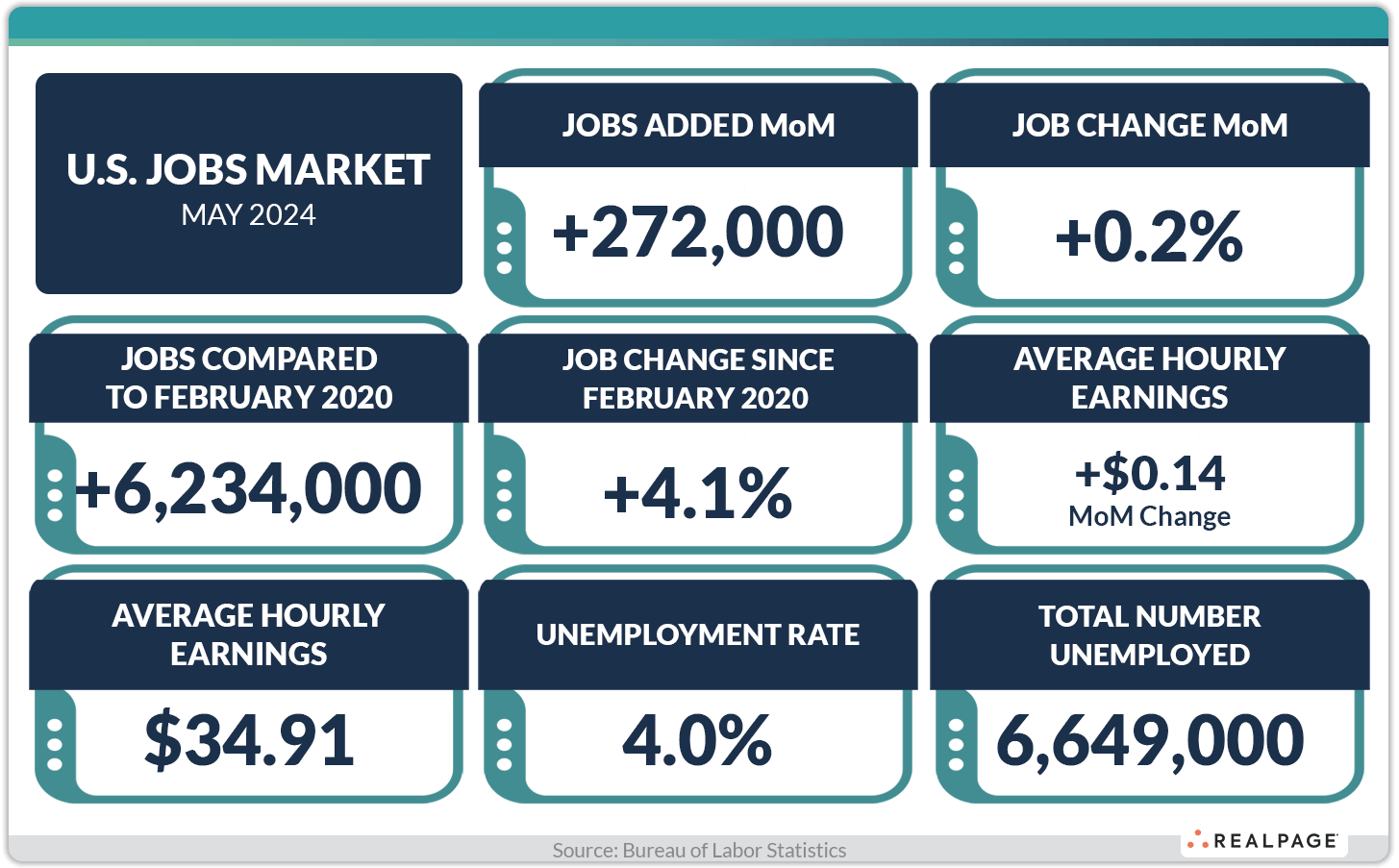As a sign of sustained economic health, hiring among U.S. employers picked up in May. The increase in hiring defied economists’ projections and came amid persistently high interest rates and slowing consumer spending. Despite the increase in hiring, the unemployment rate edged higher, against expectations.
Employers added roughly 272,000 workers to payrolls in May 2024, according to a survey of businesses by the Bureau of Labor Statistics. Those additions came in well above the 165,000 jobs gained in April (which was revised down) and was well above what economists were forecasting (+185,000 jobs to +190,000 jobs). The U.S. economy has now added jobs for 41 consecutive months, the fifth-longest period of job base expansion on record dating back to 1939.
Of note: The job counts for March and April were revised down. Downward revisions to March 2024 data showed 5,000 fewer jobs were added than previously reported, down to 310,000 positions. The April 2024 job growth number was revised down by 10,000 jobs to a total of 165,000 positions. With these revisions, employment gains in March and April combined were 15,000 jobs lower than previously reported.
Job gains in May were higher than the monthly average of around 232,000 jobs added over the previous 12 months and were well above pre-pandemic norms. From 2015 to 2019, the U.S. economy added an average of roughly 190,000 jobs each month.
On an annual basis, the nation gained nearly 2.76 million jobs as of May 2024. While that was one of the weakest annual gains over the past three years, it still registered above the pre-pandemic average of around 2.4 million jobs added annually from 2015 to 2019.
The U.S. economy has recovered all the net jobs lost during the COVID-19 pandemic. As of May, the nation had roughly 6.2 million more jobs (+4.1%) compared to the pre-pandemic employment level from February 2020.
Jobs by Industry
Most of the 11 major industry sectors gained jobs in May. The most notable job base expansions were in Education and Health Services (+86,000 jobs), Government (+43,000 jobs), Leisure and Hospitality Services (+42,000 jobs), Professional and Business Services (+33,000 jobs), Trade, Transportation and Utilities (+27,000 jobs) and Construction (+21,000 jobs). Much smaller gains were recorded in Financial Activities (+10,000 jobs), Manufacturing (+8,000 jobs) and Other Services (+6,000 jobs). Job losses were recorded in Mining and Logging (-4,000 jobs), while the number of jobs in the Information sector was essentially unchanged from April to May.

Most major industries have recovered all the jobs lost during the COVID-19 pandemic downturn. Education and Health Services has seen the best recovery, with the May 2024 job count coming in roughly 1.702 million positions ahead of February 2020 numbers, closely followed by Professional and Business Services (+1.548 million jobs). Also well ahead of pre-pandemic norms was Trade, Transportation and Utilities (+1.303 million jobs).
The Leisure and Hospitality Services sector, which was the hardest-hit sector during the pandemic, has recouped all the jobs lost during that downturn. As of May, that sector had 48,000 more jobs than in February 2020, but that was just a 0.3% increase in the job base.
Employment in the Mining and Logging and Other Services sectors have yet to recover all the jobs lost during the COVID-19 downturn. The Mining and Logging industry was 51,000 jobs below its February 2020 level, while Other Services was 34,000 jobs in the hole. That put the May 2024 employment count in Other Services 0.6% below the pre-pandemic level, while the job base in Mining and Logging was 7.5% below the February 2020 level.
Unemployment
The unemployment rate (the U3 or headline unemployment rate, which is seasonally adjusted, is a survey of households) increased 10 bps from April to May registering at 4%, the highest level since January 2022 and above economists’ expectations that the rate would hold steady at 3.9%. While the recent unemployment rate ended a 27-month streak of rates below 4%, it still marked the 30th consecutive month that the jobless rate has remained at or below 4%, the longest such streak since the late 1960s. The rise in the unemployment rate came amid the labor force participation rate that declined from 62.7% in April to 62.5% in May.
Since December 2021, the unemployment rate has been in the range of 3.4% to 4%, averaging 3.7% during that period. At the onset of the pandemic, the unemployment rate climbed to 14.8% in April 2020. Prior to the pandemic, the unemployment rate clocked in at 3.5% to 5.7% from 2015 to 2019, averaging 4.4% during that five-year period. Prior to 2023, the unemployment rate hadn’t registered below 3.5% since 1969.
The total number of unemployed persons in the U.S. registered at nearly 6.65 million in May, up from about 6.49 million in April.
The unemployment rate for adult men (20 years and over) increased 20 bps from April to May, to 3.8%. The unemployment rate for adult women (20 years and older) decreased 10 bps to 3.4%. Meanwhile, the unemployment rate for teenagers (16 to 19-year-olds) rose 60 bps from 11.7% in April to 12.3% in May.
Average Hourly Earnings
Average hourly earnings among employees on private nonfarm payrolls rose $0.14 (+0.4%) from April to May. That monthly increase took average hourly earnings to $34.91 in May. On an annual basis, average hourly earnings were up $1.37, a 4.1% increase year-over-year. Overall wage growth continues to surpass rising prices, as the Consumer Price Index rose 3.4% annually in April. The Fed’s target for inflation is currently at 2%.
Wage growth over the past year was strong across most major industries. The largest increases in earnings from May 2023 to May 2024 were recorded among workers in Financial Activities (5.6%), Manufacturing (5.1%), Construction (5%), Professional and Business Services (4.3%), Leisure and Hospitality Services (4.1%) and Mining and Logging (4.1%). The smallest increases were among employees in Information (2.5%), Education and Health Services (3.2%), Trade, Transportation and Utilities (3.7%) and Other Services (4%).












